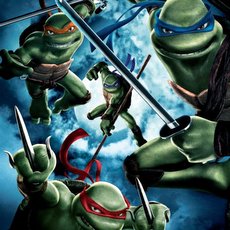Before directing this spring’s computer animated hit TMNT, Kevin Munroe had already developed quite a resume. His knowledge of art and storytelling had been made quite evident within projects ranging from video games to television series to comic books. During his career, Munroe had worked on numerous jobs for Disney, Warner Bros., Cartoon Network, Fox Kids, The Jim Henson Company, Kids WB, Dark Horse Entertainment, IDW Publishing and Nickelodeon.
Hence, Munroe was ready when the challenge came to write, produce and design the ABC Family computer animated special Donner (2001). After that undertaking, he wrote, directed, and served as lead artist for the video game Freaky Flyers (2003) for Midway Home Entertainment. Munroe then set up shop at production company Imagi Entertainment. For Imagi, he wrote the CGI comedy Cat Tale, which was placed on indefinite hold last year.
For his next film, Munroe was chosen to helm the highly anticipated return of the Teenage Mutant Ninja Turtles, TMNT. Animated News & Views’ Josh Armstrong recently had the opportunity to chat with Munroe about the feature. During the discussion, Munroe recalled his beginnings in animation and how he landed the job of directing TMNT through the blessing of Ninja Turtles‘ co-creator Peter Laird. Of course, TMNT itself was discussed, from its development to its DVD release and possible sequel.
Animated Views: How did you become involved with animation?
Kevin Munroe: I was in college, and I was well on my way to law school. I had actually graduated from high school with an art award. At the time, I had no idea what to do, because I loved writing stories. I loved art.
 But animation was nowhere near as accessible as it is now. I mean, it wasn’t that long ago — just right before Aladdin came out, sometime right after Beauty and the Beast. In Canada, there weren’t any animation schools. You don’t go through high school thinking about attending one. So, I found myself doodling in all my notepads. I just couldn’t stop doing it!
But animation was nowhere near as accessible as it is now. I mean, it wasn’t that long ago — just right before Aladdin came out, sometime right after Beauty and the Beast. In Canada, there weren’t any animation schools. You don’t go through high school thinking about attending one. So, I found myself doodling in all my notepads. I just couldn’t stop doing it!
Then my wife and I were on a vacation at Disney World, and we went to the animation tour in the Florida facility. And it just hit me like a ton of bricks! It was a perfect combination of everything I love. I immediately went through the tour like five times. My wife got bored and just sat outside while I kept doing it.
 I waited around and asked animators about where to go, and I immediately ran to the bookstore to find books and information. It turned out Sheridan College in Toronto was a big school. So, I went there for a year. After that, I started working a lot of freelance. I started doing character design, prop design, storyboards — mostly in-development things. I went to California about a year later and started working on video games. I just loved every aspect of animation, whether it was TV, film or video games. It was always about just trying to tell stories or do really cool-looking art.
I waited around and asked animators about where to go, and I immediately ran to the bookstore to find books and information. It turned out Sheridan College in Toronto was a big school. So, I went there for a year. After that, I started working a lot of freelance. I started doing character design, prop design, storyboards — mostly in-development things. I went to California about a year later and started working on video games. I just loved every aspect of animation, whether it was TV, film or video games. It was always about just trying to tell stories or do really cool-looking art.
Wow, that’s the longest answer ever.
AV: I’ve heard longer. [laughs] I’d like to briefly talk about Cat Tale. How did you become attached to that project?
 KM: At the production company Imagi, they were working on this project called Cat Tale. They had a script, and they wanted me to come in and do a “comedy re-write” on it, basically making it funny. So, I came in.
KM: At the production company Imagi, they were working on this project called Cat Tale. They had a script, and they wanted me to come in and do a “comedy re-write” on it, basically making it funny. So, I came in.
Ironically, it was one of those movies that is just like every CGI movie that’s out there. It was a really charming story about a cat who thinks he’s a dog. We got a really great cast.
While we were working on that, I heard the company was trying to get the rights to Turtles, and I just completely – I really shelled hard for that job. [laughs] But Cat Tale, right now, I think it’s sort of on indefinite hold, simply because the company is trying to base its profile around movies like Turtles.
 This is the studio that won’t give you that cute and cuddly morality tale, where four outsider animals go on a road trip and discover that it’s okay to be different or something. This is the boy’s action studio, I think. That’s sort of the big thing we’re saying — “How do you make boy’s action accessible to a broad audience?” After Turtles was well on its way, we realized, “You know what, at least theatrically, Cat Tale just doesn’t seem like the right follow-up for the studio.”
This is the studio that won’t give you that cute and cuddly morality tale, where four outsider animals go on a road trip and discover that it’s okay to be different or something. This is the boy’s action studio, I think. That’s sort of the big thing we’re saying — “How do you make boy’s action accessible to a broad audience?” After Turtles was well on its way, we realized, “You know what, at least theatrically, Cat Tale just doesn’t seem like the right follow-up for the studio.”
But we’re still trying to figure out what to do with it, because it’s a fun project and it’s really cute. The characters are funny, and the voice cast is great. We got Stanley Tucci, Sean Astin, Elisha Cuthbert… It’s just a fun cast.
AV: There was a rumor that Cat Tale was going to be distributed by Disney. Was there any truth to that?
KM: I don’t think so. Actually, I think we met with every studio in town. So, maybe that’s where that came from. But no, I don’t think Disney was ever interested in it.
AV: Could you elaborate more on how you became involved with TMNT?
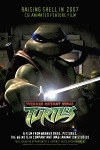 KM: I was working on Cat Tale, and I overheard them talking about how they wanted to go after the Turtles license. I said, “Do you realize what this movie could be?” I almost felt like this was my opportunity to get on my soapbox about what animation could be, basically saying, “This doesn’t have to be Madagascar with Ninja Turtles! This can actually be gritty and comic book-y and really cool!”
KM: I was working on Cat Tale, and I overheard them talking about how they wanted to go after the Turtles license. I said, “Do you realize what this movie could be?” I almost felt like this was my opportunity to get on my soapbox about what animation could be, basically saying, “This doesn’t have to be Madagascar with Ninja Turtles! This can actually be gritty and comic book-y and really cool!”
I pestered them. Eventually, I think just to get me off their backs, they sent me to North Hampton, Massachusetts, to meet with the creator of the Turtles [Peter Laird], to see if I could get his blessing to direct the movie. So, that was cool.
AV: How did you get that blessing?
KM: I actually went back to 1985, when I found the first issue of the Turtles comic. It was about a year and a half after it had come out. It was in a used bin. I was immediately struck by the action and the comedy that’s in it. I just loved that mix. To me, it’s like Ghostbusters and Pirates Of The Caribbean. Anything that mixes those two genres really well is great.
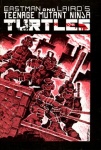 Twenty years later, I got a chance to fly to North Hampton and basically pitch myself as the director for that same comic book I bought twenty years before. I sat down with Peter and knew that other people had met with him. I knew that he was getting pitched like the R-rated Ninja Turtles movie, or he was getting pitched the action-packed, really gritty thing.
Twenty years later, I got a chance to fly to North Hampton and basically pitch myself as the director for that same comic book I bought twenty years before. I sat down with Peter and knew that other people had met with him. I knew that he was getting pitched like the R-rated Ninja Turtles movie, or he was getting pitched the action-packed, really gritty thing.
I knew the action could come. But to me, I went there, and I just told him that I wanted to do a story about family. I wanted to make it a story about brothers that you honestly believe relate to each other and have lived with each other for 18 or 19 years. They fight; they make up. They battle together, and they live in trenches together.
I took out my Issue #1 and slid it across the table. I figured, “You know what, if I don’t get the job, at least I’ll get it signed, right?” On my way back to the airport, I opened it up. There was a drawing of Raphael, and on it was written, “Dear Kevin, make a good movie — or else!” So, I got the book signed and got the job!
AV: Do you know of any other directors who were in the running?
KM: No, I don’t know. They didn’t tell me because they probably figured it’d hurt my feelings. I know they spoke to a lot of people. I couldn’t tell you why I was the one who got picked, other than I was probably really cheap to hire.
But otherwise, I had a genuine enthusiasm for the project. Pete needed somebody who had that and who also understood the things Pete needed as well.
 AV: At one time, John Woo was planning a Ninja Turtles movie. Regarding story and design elements, was anything carried over from that project to yours?
AV: At one time, John Woo was planning a Ninja Turtles movie. Regarding story and design elements, was anything carried over from that project to yours?
KM: The John Woo stuff — I’ve never seen anything that happened. I love the idea of that. I mean, John Woo doing a Turtles film seems really cool. But no, there was nothing carried over. It was a different production company. I don’t even know if they did any work at all on it.
AV: To what extent was Peter Laird involved with your film?
KM: He was really involved, from day one. We worked on the story treatment for a good four or five months with Pete. He’s actually a producer, in the credits. There are so many people who get those credits and don’t do anything. But Pete did a lot of reviewing and creative direction.
 At the beginning, he has these rules. They’re really funny; they’re the “Peter rules.” He would just come down hard, saying that “Turtles don’t have fingernails! Don’t put fingernails on the Turtles!” We’d be like, “But, Pete, it’s just fingernails.” [laughs] But then we’d be like, “Hey, Pete, we want to completely redesign the Turtles, so that they look more like teenagers.” And he’d be like, “Eh, okay. Cool. Sounds like a good idea.” It was really funny. We had these really cool utility designs for [the Turtles’] belts. We said, “What about these, Pete?” Then we got back this half-page rant about how those belts don’t work and how he wants the traditional leather-strap belts.
At the beginning, he has these rules. They’re really funny; they’re the “Peter rules.” He would just come down hard, saying that “Turtles don’t have fingernails! Don’t put fingernails on the Turtles!” We’d be like, “But, Pete, it’s just fingernails.” [laughs] But then we’d be like, “Hey, Pete, we want to completely redesign the Turtles, so that they look more like teenagers.” And he’d be like, “Eh, okay. Cool. Sounds like a good idea.” It was really funny. We had these really cool utility designs for [the Turtles’] belts. We said, “What about these, Pete?” Then we got back this half-page rant about how those belts don’t work and how he wants the traditional leather-strap belts.
So, yeah, he was really involved with it. I think the area he first lightened up with was probably the visuals. I think as soon as he saw the test images coming back, he knew that we were on the right track.
AV: Can you think of any of the other rules that Pete had?
KM: Turtles are not interested in girls — at all. Not that I probably would have wanted that anyway, but it’s a big pet peeve with Pete. It’s like you having a crush on a French poodle. He’s a turtle, and she’s a human. There would be no crossover, right? So, there was that.
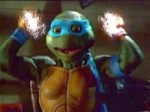 There’s absolutely no mention of Venus de Milo, the female Turtle. You can’t even joke about that with Peter. It’s just one of those things that he hates with a passion.
There’s absolutely no mention of Venus de Milo, the female Turtle. You can’t even joke about that with Peter. It’s just one of those things that he hates with a passion.
Let’s see, there are a lot of rules about the Turtles’ movement. Basically, he felt that there was a certain limit to which their action could be pushed. For instance, a Turtle can’t jump up twenty feet in the air. He was kind of a watchdog for that, at the beginning, which was cool.
Oh, and other stuff too — and I love this kind of writing anyway, but it was cool that he supported it: the way the characters spoke. Donatello, being the smart one, never speaks in contractions. It’s only Mikey or Raph who would drop the g‘s at the end of their words. They might say “walkin.” But Leo would never say “walkin.” He would say “walking.”
So, it was fun. Peter was really into the characters. He loves it.
 AV: Was Turtles‘ co-creator Kevin Eastman involved at all with the film?
AV: Was Turtles‘ co-creator Kevin Eastman involved at all with the film?
KM: No, he wasn’t actually. Peter bought out Kevin. I forget when — I think around the year 2000. So, Pete controls the franchise.
AV: How does your film fit into the Turtles universe? For instance, is it more of a continuation to the first three films, or the latest TV series?
KM: You know, it’s funny. There’s so much you can do. There’s so much in the Turtles’ past, as far as adventures and stuff. So, when we first started, we were trying to find what we were going to say – what was going to be lore and what wasn’t, for the movie. At the end of the day, we realized, “Let’s just make the whole thing lore.”
Basically, they’ve lived all these adventures, and they’ve defeated all these villains. Now they find themselves without direction, because they don’t have a common enemy to fight anymore. The movie became more about a rebirth of the heroes, instead of an origin story.
AV: Obviously, there were people wanting the film to be lighter, while others wanted it to have a darker tone. How did you try to please both groups?
KM: You know, it’s really hard. I love action-comedy pieces. I love Ghostbusters, Lethal Weapon and Die Hard. To me, they’re the perfect mix of action and comedy.
For this movie, it was just about teaming up with people that I knew had that same sense of humor. We set out at least to lean that way, really making sure that we treated [the Turtles] as real, the stakes as being real. When you do that, you create real drama and the real character-based stuff, and it’s no problem for you to then sort of crack a joke or something if you need to.
It’s definitely more of an action-adventure this time around. I think [in past Turtles projects], it was more of an adventure-comedy. So, it was just sort of going back to the comic book and remembering what we all loved about the comic book.
AV: What was the most challenging aspect of writing and directing TMNT?
KM: It was making sure that we hit the core demographic that loves the Turtles. I think that was sort of the big thing. We wanted to make sure that we serviced those people, because they’re the ones who grew up with the Turtles.
It was that, and then it was also Imagi. TMNT was their first animated feature. So, it was the pipeline; it was communication. It was a lot of materials going back and forth. But at the end of the day, it worked out all right.
AV: In other interviews, you’ve mentioned that you didn’t want celebrity voices for the Turtles. But you got celebrity voices for the supporting characters…
KM: Yeah, because I’m a complete sell-out — nah, I’m just kidding. [laughs] We were really adamant about the Turtles. To me, that was sort of my Waterloo, in terms of casting. I really wanted to make sure that when you heard the Turtles, you heard just the Turtles. You didn’t hear Tom Cruise doing the voice of Leonardo. We’re sort of the anti-DreamWorks, in that respect. And that was a hard one, because we’re talking about the four heroes in the movie.
When we talked about the other voice casting, we still cast all those voices due to the characters. We weren’t really worried about stunt casting. You know, Sarah Michelle [Gellar] just fit the character of April, which was really great. Patrick Stewart was a great bad guy. Everything fit. So, I never really felt like we were trying to show-off any celebrity.
Even before Turtles, I was sort of anti-celebrity casting, all-around. But just because they’re a celebrity, doesn’t mean they’re not a good voice actor. About our voice casting, I mean, they’re all really good voices. You can’t get much better than Patrick Stewart.
AV: Could you elaborate on any scenes or concepts cut from the film?
KM: The biggest thing that I was sad to see go was, we had a really strong subplot with April and Casey. We had advanced their relationship, in that they were living together. She had asked him to stop being a vigilante. He’d actually stopped, but he was still sneaking out, like a smoker would go out and take a puff at night. He would go out, and take his bat and his mask, and do vigilante stuff. She knew he was doing that. But they didn’t talk about it.
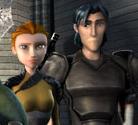 It was a really nice, mature relationship, and it was a really strained relationship. It was all about her realizing that she can’t change Casey, and him realizing that he has to be a little more responsible. It was a really great subplot.
It was a really nice, mature relationship, and it was a really strained relationship. It was all about her realizing that she can’t change Casey, and him realizing that he has to be a little more responsible. It was a really great subplot.
But at the end of the day, after you get Turtles, monsters coming through the city, and this big sci-fi setup, it was at a third or even fourth level of importance. It just couldn’t survive on-screen and not be a two-hour movie, which we were told not to do. It was just one of those things. We even had them get engaged at the end, which was kind of fun.
That’ll be in the cut scenes on the DVD. You’ll actually see some of those sequences.
AV: Will the cut footage be in a Deleted Scenes section, or as part of an extended edition for TMNT?
 KM: I think it’s just going to be deleted scenes, because we didn’t go full-fledged animation. We talked about basically doing a director’s cut, with the film jumping to the storyboards or something — sort of the in-progress director’s cut. But it’s better to say, “This is the movie, and here’s some stuff that didn’t make it.”
KM: I think it’s just going to be deleted scenes, because we didn’t go full-fledged animation. We talked about basically doing a director’s cut, with the film jumping to the storyboards or something — sort of the in-progress director’s cut. But it’s better to say, “This is the movie, and here’s some stuff that didn’t make it.”
AV: Are there any inside jokes or references that folks should look for, in the film?
KM: Oh yeah, there’s a lot. There’s an alcove in the Turtles’ lair, where you see artifacts from their past adventures in comics, TV… There’s an object in a guy’s office that’s a nice throwback to a Turtles villain. There are a few lines of dialogue that are actually lifted from the comic books. There are little bits in there that, if you’re a fan, you’ll notice.
AV: Looking back on the film, is there anything you would like to change? Anything you wish you had done differently?
KM: No, I think, in tone, we were sort of spot on. I’m happy with it. I think it’s good. I would have loved to have a longer running time. That would be the only the thing I would say I would have loved to have. That’s not because I think the story needs to be a longer story. But I’m just completely self-indulgent. [laughs] I want to see more Turtles stuff, and I want to see longer scenes. I want to see that kind of stuff. But for the most part, it’s all cool.
AV: Were you given a restriction as to how long the movie had to be?
KM: No, there wasn’t a set time. But everybody gets involved — the studios and production company — and there are the production costs for how much you can afford to animate. It’s cool, though. Everything sort of comes down to DVD, too, which is kind of neat. But we were never told that the film had to have a specific running time.
AV: What can you tell us about any possible TMNT sequels? There has been a lot of talk about Shredder returning, but what about other characters?
KM: You know, it’s funny, because it’s never been more than a lunchtime conversation between me and my friend Tom Tanaka, who was an assistant director on the movie and did a lot of the story work as well. I mean, there’s nothing set yet.
Shredder — it would be cool to see. I’d love to see us explore the Karai and Foot Ninja thing a little more. I love the Rat King, even though he’s such a one-opp villain, but I still think it would be kind of cool to go back to him. I’d love to use — and this is sort of the “out there” one, as I don’t think it would work for our next sequel — the Triceratons. I think that would be really fun — the idea of traveling to that planet or them invading or something.
There’s a lot out there. We come up with ideas for Peter: “Okay, Pete, they time-travel back, and they explore Mayan culture, and they fight aliens, who just happen to be teleporting back at the same time.” And he’s like, “Eh, we did it in 1992.” Stuff like that. I mean, the Turtles have been everywhere. There’s so much source material.
AV: Regarding the unfortunate passing of Mako, have you given any thought about who might voice Splinter in the next TMNT movie?
 KM: I know that there are a couple of voice actors out there who do double for Mako, because I know he still has commitments on Avatar: The Last Airbender and a couple of other shows. So, I don’t know. We haven’t even talked about it.
KM: I know that there are a couple of voice actors out there who do double for Mako, because I know he still has commitments on Avatar: The Last Airbender and a couple of other shows. So, I don’t know. We haven’t even talked about it.
It’s weird. It’s almost like you just want to let it lie, at this point. It seems like, “Is it a tribute to have somebody who sounds like Mako, or is it better to just recast it?” I don’t know. This is just my opinion, not the company’s. To me, I would probably rather recast instead of having somebody who sounds like Mako, because I don’t think anybody can really match Mako.
AV: What advice would you like to offer anyone wanting to work in the animation industry?
KM: There are so many factors of animation. But to me, it’s always about storytelling. Whether or not you’re drawing comic books, or even animating little scenes or whatever, it’s always about finding a way to tell stories.
I’m a big fan of modeling, in the sense that you find somebody whom you admire or whose work you admire. You just start looking at what they do and start drawing like they do. You start doing stuff like they do, trying to figure out what it is about their work that makes it so appealing to you. Then, eventually, you’ll branch out and start creating your own style. If you love Chuck Jones’ drawings, start drawing like Chuck Jones, to see why he chose lines the way he did. You’ll eventually spin off into your own sense of style.
Also, have tenacity. Every day that you get up, keep trying. There will be somebody else who’s dropping out, because they just can’t take it anymore. When you get up like Rocky and fix raw eggs and stuff, and keep on trying and sending out your portfolio for the 100th time, you’re still making an effort that someone else isn’t that day.
Animated News & Views sends our sincerest gratitude to Kevin Munroe for his participation in the interview. In addition, we appreciate Orna Zadeh of Warner Bros. for arranging the conversation.


